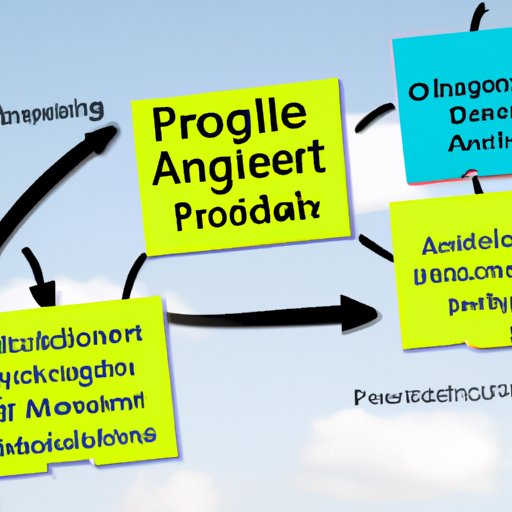Introduction
Agile project management is an iterative approach to managing projects that focuses on collaboration, flexibility, and continuous improvement. This methodology can be used to create better products faster, with greater efficiency and less risk. In this article, we’ll explore the advantages of agile project management, its principles and practices, and how to implement it in your organization.

Exploring the Benefits of Agile Project Management
Adopting agile project management techniques can have a number of benefits for your team, including:
Increased Efficiency
Agile methodology emphasizes incremental development and continuous improvement. By breaking down large projects into smaller tasks and continuously assessing progress, teams can complete projects more quickly and efficiently. Agile also allows teams to prioritize tasks, so they can focus on the most important tasks first.
Reduced Risk
The iterative nature of agile project management makes it easier to identify potential risks early on in the process, reducing the likelihood of costly errors and delays. The ability to quickly implement changes also reduces the risk of launching a product or service that doesn’t meet customer requirements.
Improved Communication
Agile encourages regular communication between team members, stakeholders, and customers. This helps ensure that everyone is on the same page and that any issues or concerns are addressed quickly, allowing teams to stay focused on the task at hand.

An Overview of Agile Principles and Practices
There are several different approaches to agile project management. Some of the most popular include:
Scrum
Scrum is a popular agile methodology that emphasizes short sprints and frequent feedback. Teams use Scrum to break down complex tasks into smaller, more manageable chunks and track their progress along the way. It also includes meetings such as daily standups and retrospectives to ensure everyone is on the same page.
Kanban
Kanban is another popular agile methodology that emphasizes visualizing workflows and tracking progress. Teams use Kanban boards to visualize tasks, prioritize them, and track their progress. This helps teams focus on the most important tasks and identify areas where they need to improve.
Lean Software Development
Lean software development is an agile methodology that emphasizes minimizing waste and maximizing value. Teams use Lean to reduce lead times and increase customer satisfaction by focusing on what adds value and eliminating anything that doesn’t. This helps teams create better products faster.
Extreme Programming (XP)
Extreme programming (XP) is an agile methodology that emphasizes collaboration and continuous improvement. Teams use XP to develop high-quality software quickly by following a set of coding standards and engaging in frequent testing and refactoring. This helps teams create reliable, robust software faster.
The Impact of Agile Project Management on Efficiency
By adopting agile project management techniques, teams can expect to see increased efficiency in a number of areas, including:
Increased Productivity
Agile project management encourages teams to focus on the most important tasks and prioritize them accordingly. This helps teams become more productive, as they are able to complete tasks more quickly and efficiently.
Improved Quality
The iterative nature of agile project management allows teams to quickly identify and address any issues before they become major problems. This helps ensure that the final product meets customer requirements and is of high quality.
Shorter Time-to-Market
By breaking down large projects into smaller tasks and iteratively developing them, teams can reduce the time it takes to get products to market. This can give teams a competitive edge and help them capitalize on emerging trends.
A Step-by-Step Guide to Implementing Agile Techniques
If you’re looking to adopt agile project management techniques, here’s a step-by-step guide to getting started:
Assessing Your Current Processes
Before you start implementing agile techniques, take some time to assess your current processes. Identify areas where you could improve efficiency, reduce risk, or increase collaboration. This will help you determine which agile principles and practices you should focus on.
Establishing Clear Goals
Once you’ve identified areas that need improvement, establish clear goals for your team. This will help ensure everyone is on the same page and working towards the same objectives.
Selecting the Appropriate Toolset
Next, select the appropriate toolset to support your agile project management efforts. This could include tools such as Scrum boards, Kanban boards, task tracking software, and more.
Creating an Agile Team
In order for agile project management to be successful, you’ll need to create an agile team. This should include people from all areas of the organization, with varying levels of expertise. Everyone should be able to contribute to the process and collaborate effectively.
Scheduling Iterative Sprints
Once you’ve established your team, start scheduling iterative sprints. This will help keep your team focused on the most important tasks and ensure that progress is being made. Make sure to schedule regular meetings to discuss progress and make adjustments as needed.
Adopting Continuous Improvement Practices
Finally, make sure to adopt continuous improvement practices. This could include conducting retrospectives after each sprint to identify areas for improvement, engaging in regular testing and refactoring, and gathering customer feedback. This will help ensure that your team is continuously improving and creating better products faster.
Common Challenges of Adopting Agile Techniques
While there are many advantages to adopting agile project management techniques, there are also some common challenges associated with it. These include:
Resistance to Change
One of the biggest challenges of adopting agile is overcoming resistance to change. People may be reluctant to embrace new methods or tools, so it’s important to explain the benefits and help people understand why the change is necessary.
Poorly Defined Requirements
Another challenge is ensuring that requirements are well defined. Without clearly defined requirements, teams may struggle to prioritize tasks and track progress. Make sure to define requirements early on in the process and review them regularly.
Lack of Structure and Discipline
Finally, teams may struggle to stay disciplined and organized when using agile techniques. It’s important to create a structure for the team to follow and ensure that everyone is held accountable for their tasks. Regular check-ins can help ensure that everyone is on the same page and making progress.

Case Studies of Agile Project Management Success
To better understand how agile project management techniques can benefit organizations, let’s look at three case studies of successful implementations:
Example 1
One company adopted agile project management to streamline their development process. They created an agile team and implemented Scrum to break down tasks into smaller chunks and prioritize them. They also adopted continuous improvement practices, such as conducting retrospectives and engaging in frequent testing and refactoring. As a result, they were able to reduce their lead time by 25%, resulting in increased customer satisfaction.
Example 2
Another company adopted agile project management to reduce the risk of costly errors and delays. They implemented Kanban to visualize their workflow and track progress. They also conducted regular retrospectives to identify areas for improvement and engaged in frequent testing and refactoring. As a result, they were able to reduce the risk of errors and delays by 30%.
Example 3
A third company adopted agile project management to reduce the time it took to get products to market. They implemented Lean software development to focus on what adds value and eliminate anything that doesn’t. They also conducted regular retrospectives and adopted continuous improvement practices. As a result, they were able to reduce their time-to-market by 35%, giving them a competitive edge.
Conclusion
Agile project management techniques can have a number of benefits for organizations, including increased efficiency, reduced risk, improved communication, and a shorter time-to-market. By following a step-by-step guide to implementing these techniques and adopting continuous improvement practices, teams can create better products faster and gain a competitive advantage. The case studies discussed above demonstrate that agile project management can be a powerful tool for organizations looking to streamline their development process.
(Note: Is this article not meeting your expectations? Do you have knowledge or insights to share? Unlock new opportunities and expand your reach by joining our authors team. Click Registration to join us and share your expertise with our readers.)
